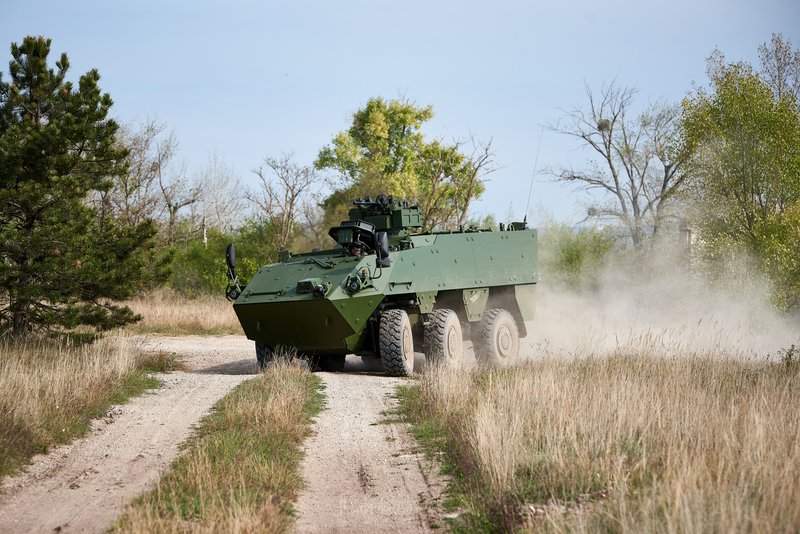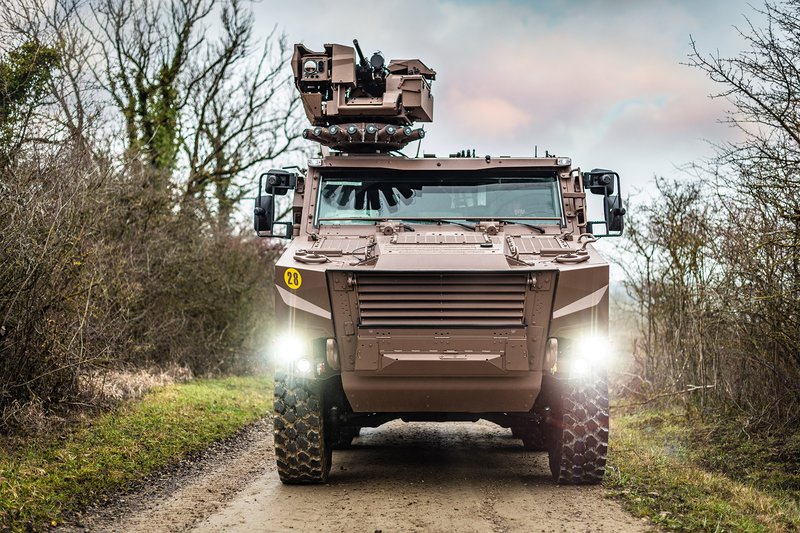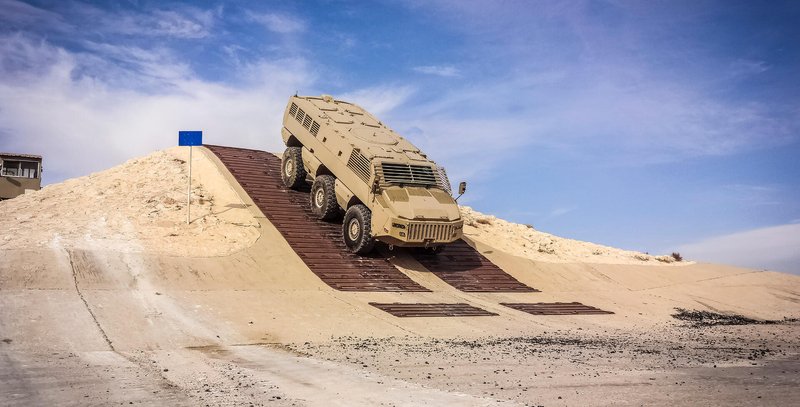Six of the best – why the 6x6 APC is enjoying a renaissance
As many armies worldwide look to replace or augment their 8x8 fleets with 6x6 platforms, this month’s newsletter looks at what is driving this trend, who is ordering these systems, and what options exist on the global market.
A significant number of countries have deployed 8x8 vehicles in the baseline armoured personnel carrier (APC) role, but there is now a trend to develop these into infantry fighting vehicles (IFVs) fitted with a crewed or remote-controlled turret (RCT) armed with a medium-calibre cannon and co-axial machine gun (MG)... Continues below
Newsletter Sponsors:

Above: Austria has always preferred 6x6 vehicles. This is the latest Pandur Evo fitted with an Elbit RWS armed with a 12.7mm MG. (Photo: GDELS)
Running alongside this is a move towards also fielding 6x6 APCs, as their more compact design allows them to be deployed in confined areas, as well as making them easier to transport by air. In addition, they are better suited to internal security missions than their larger and heavier 8x8 counterparts.
As with the 8x8s, more recent 6x6 APC designs are provided with higher levels of survivability and better armament, often a remote weapon station (RWS) mounting a stabilised 12.7mm MG or 40mm automatic grenade launcher.
In addition, most have an electronic architecture to allow for easier upgrades in future, a battle management system, multiple cameras for situational awareness through 360 degrees and an environmental control unit for worldwide operations in different climates.

The Austrian Army has always preferred a 6x6 rather than an 8x8 and it became the launch customer for the privately developed Steyr-Daimer-Puch (now GDELS) Pandur APC, with the first of 71 examples coming off the Vienna production line in December 1995.
This was followed by sales to Belgium, Gabon (for trials), Kuwait’s national guard, Slovenia and the US for deployment by US Special Operations Command as the Armored Ground Mobility System.
The Pandur can be fitted with a range of weapons, with some of the Kuwaiti examples sporting a two-person turret armed with a 90mm gun and coaxial MG.
The original Austrian Army Pandurs have been upgraded several times and supplemented by three additional contracts for the Evo model, covering 34, 30 and 36 units respectively.
Early in 2024 it placed yet another contract for 225 Pandur Evos worth some €1.2 billion, under which GDELS will supply eight variants including a 120mm mortar carrier and Rheinmetall 30mm SkyRanger air defence systems.
Some countries never moved to 8x8s; for many years Brazil has operated large fleets of Engesa EE-9 Cascavel 90mm-armed 6x6 armoured cars and EE-11 Urutu 6x6 APCs, with large numbers of these exported before the company ceased operations.
The Urutu is now being replaced by the locally manufactured Guarani 6x6 APC which is fully amphibious and typically armed with a protected weapon station (PWS) or RWS mounting an MK44 dual-feed cannon and 7.62mm coaxial MG.
Gross vehicle weight (GVW) depends on the version but is typically around 18.3t. Export sales have been made to Ghana, Lebanon and the Philippines. The Brazilian Army requirement is for 2,044 vehicles by 2030, funding permitting.
For its part, China developed and placed in production the WZ-551 6x6 APC which is designated the Type 92 by the Peoples Liberation Army (PLA) and has been built in large numbers for home and export markets and used for a wide range of battlefield missions, including as a launch platform for air defence missiles.
A developed version is known as the WMZ-551, while the similar VN2B has a turret armed with a 30mm cannon, 7.62mm MG and HJ-74 antitank missiles. The VN2C has a higher level of ballistic and mine protection.

More recently China has developed the VN22 6x6 APC which is already being manufactured in Iraq. This is a conventional design with the driver front left, and diesel power pack to the right, leaving the remainder of the hull clear for weapon system and dismounts.
France meanwhile replaced its tracked AMX-10Ps with 630 Nexter (now KNDS) VBCIs in two configurations, IFV and command post. These were deployed alongside the Arquus VAB 4x4 but are now being rapidly replaced by the Griffon 6x6 mentioned below.
Around 5,000 VABs were built with the French Army being the largest user but only in 4x4 configuration. A 6x6 model was developed and exported to customers including Côte d’Ivoire, Cyprus, Italy, Mauritius, Morocco, Oman, Qatar and the UAE but in some cases these have already been replaced.
Arquus also developed, using internal R&D funding, the VAB Mk 3 which is pitched at export sales and marketed only in 6x6 configuration. The baseline vehicle is fully amphibious but when fitted with applique armour this capability is lost.
VAB Mk 3s have already been sold to Saudi Arabia and Tunisia (via Mack Defense of the US and known as the Lakota). It can be fitted with a range of armament options including a John Cockerill Defense two-person turret mounting a 90mm gun and 7.62mm coaxial MG.

Above: The Griffon 6x6 APC is rapidly replacing the Arquus VAB 4x4 in the French Army. (Photo: KNDS)
The successor Griffon 6x6 was the first of a new generation of AFVs to be deployed by the French Army as part of the ambitious SCORPION programme.
Compared to the VAB, Griffon has more volume, payload and protection with the first member of the family being an APC, but there will be at least ten variants including 120mm mortar, command post, forward observer and ambulance.
The French Army has a requirement for 1,872 Griffons with over 600 built, while Belgium will take delivery of 382 units.
Production is undertaken at the KNDS facility in Roanne with key partners including Arquus (power pack and drive line) and Thales (optronics). The Griffon APC is fitted with an Arquus Hornet RWS.
Using private funding KNDS has developed the Tactical Infantry Transport & Utility System (TITUS) 6x6 which has a high level of cross-country mobility as it is based on a Tatra 817 truck chassis.
TITUS has a typical GVW of up to 27t and a high level of protection against mines and IEDs. It can be fitted with various roof-mounted weapons including an RCT armed with a 30mm cannon and 7.62 mm MG.
The first customer was the Czech Republic which has taken delivery of 62 in three versions: communications (36), command (six) and fire support co-ordination (20).
Finland’s Patria built large numbers of XA series 6x6 APCs for home and export markets and then went on to develop the highly successful Armoured Modular Vehicle (AMV) 8x8. There was a 6x6 model of the AMV but this did not enter production.
Its latest product is the Common Armoured Vehicle System (CAVS) which has so far been selected by Estonia, Finland, and Sweden with Germany joining the R&D phase on 2 May this year.
Production is already well under way with the latest contract being placed by Sweden in March for 321 vehicles.
The German Army itself deployed almost 1,000 Fuchs 6x6 APC in many variants. Since it was first introduced in 1979 it has been constantly upgraded with the latest version being the Fuchs 1A8.
Further development resulted in the RMMV Fuchs 2 with more volume, payload and protection with a typical GVW of up to 23t.
Kuwait has taken delivery of 12 and the UAE has 32 in the specialised NBC reconnaissance role, while Algeria has been building the design under licence for many years with the first batch consisting of 920 units, with RMMV still supplying some subsystems such as power packs and suspensions.
More recently, additional Fuchs 2 vehicles have been ordered by Algeria and production is earmarked to be undertaken in Ukraine.
Indonesia’s PT Pindad has developed a similar vehicle to the French VAB called the Anoa which was originally fitted with a PWS typically armed with a 12.7mm MG. More specialised versions have since been fielded including an amphibious model, ambulance, recovery, cargo and mortar carrier variants.
In addition, there is a direct fire variant called Badak which has a different hull design with the driver in front, a John Cockerill Defense two-person 90mm turret in the centre and diesel power pack at the rear.
South Korea’s Doosan developed the Black Fox Armoured Wheeled Vehicle in both 6x6 and 8x8 versions, but this was not selected by the ROK Army. The type was offered for export and 22 of the 6x6 model were built for Indonesia fitted with a 90mm turret.
The original ROK Army competition was won by Hyundai Rotem with its KW1 (6x6) and KW2 (8x8), with both being fully amphibious. The first contract was for 675 units in a mixture of configurations with the long-term requirement for well over 2,500.

Above: The Mbombe 6x6 is a member of a complete family of vehicles developed by Paramount for the international market. The weapon station would be installed on the large circular panel in the middle of the roof. (Photo: Paramount)
South Africa’s Paramount has completed development of its Mbombe 6x6 vehicle which has a GVW of up to 22.5t and can be fitted with weapon systems including turrets armed with 30mm cannon and a 7.62mm MG.
Mbombe is also marketed in 4x4 and 8x8 configurations which share common components with obvious training and logistical advantages. The first customer was Jordan, followed by Kazakhstan (local production) an unspecified country in the South African Development Community and, most recently, Ecuador.
Turkish company FNSS Savunma Sistemleri built large numbers of tracked vehicles for home and export customers but subsequently moved into the highly competitive wheeled market. Its first success was with the Pars 8x8 for Malaysia.
This was followed by Oman placing a contract for 172 Pars with some in 6x6 configuration fitted with a FNSS Sabre one-person turret armed with a 25mm cannon and coaxial 7.62mm MG.
More recently FNSS was awarded a contract by the Turkish government for the latest generation of Pars which includes both 8x8 and 6x6 versions, with some of the latter for use by special forces. Libya has also taken delivery of some Pars 8x8 and 6x6.
Fellow Turkish company Otokar has built large numbers of armoured vehicles for domestic and overseas customers.
One of its more recent developments is the Arma family which is marketed in 6x6 and 8x8 configurations. The 6x6 is known to have been sold to Bahrain, and the latest customer is Estonia. In March 2024 a spokesperson for Otokar said that total production of the Arma in both 6x6 and 8x8 form was now over 500 units.
A combination of lower cost and greater mobility, plus the advent of increasingly powerful yet compact turrets and RWS, has created a vibrant market for 6x6 platforms in the APC and other roles. As ever though, the question must be asked as to whether all the competing designs available will end up as profitable programmes…
Other articles in this newsletter:
Will Paramount’s Mbombe 6 APC be built in Ukraine?
Why was there no proper competition for the British Army’s Mobile Fires Platform?
Don't want to miss out on future Decisive Edge content? Make sure you are signed up to our email newsletters.












